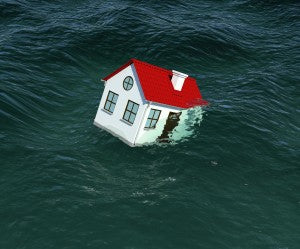
There aren’t many places in the United States that are immune to flooding, so if you think you live or work in one of them, you’re probably mistaken. After all,
flooding is the most common natural disaster in the country. From rivers overflowing their bounds to rain cascading down a parched hillside, and even broken water mains, there are
many causes for floods. When floods do come, you’ll want to have your preparations done well in advanced. So how can you protect your home from flooding? Let’s explore some options.
- Clean Gutters and Drains

Gutters and drains are designed to
transport rain water and melting snow away from your home. If your gutters aren’t clear of debris, however, that can cause overflowing and bring unwanted water much too close to your home. If there’s enough of that spill over, it can start seeping in to your home. The same thing goes with drains. If the street drains are blocked by leaves, dirt, and other obstacles, that will block the water from escaping, making it deeper and more likely to flow into your home. During heavy rains, it’s recommended to check those drains in your neighborhood, just to make sure they’re clear.
- Extra Roof Protection
Why do you have a roof to begin with? It’s to keep out the rain and bad weather that happens all around you. So why, then, would you not keep your roof in prime condition? Bad roofing can cause rain and melting snow to leak through your roof into your home, causing damage. If you have an attic, you may not even realize your roof is leaking until the damage becomes bad enough. The next time you repair your roof, consider installing a
rubber underlayment, which will help waterproof your roof.
- Know Your Threat Level
Not all homes are created equal. Some are built on floodplains while others are built far away from rivers or other natural water sources. Some are built on hills and some at their base. No matter where you live, however, there’s always a threat of flooding. By knowing your risk, you can more properly prepare, including how much flood insurance you should get.
- Flood Insurance

Speaking of flood insurance… While not technically a way to protect your home from flood damage, it
is a way to protect yourself from covering all the costs of such damage. While you’ll still have to pay deductibles, it’s a lot better than having to spot the bill for everything damaged. When looking in to a policy, make sure you understand what’s covered. Not all flooding is covered in your policy. For example, Flood Smart informs us that floods caused by sewer backups is only covered by flood insurance if the backup was caused by a flood itself. Otherwise, no deal. So make sure you know what you’re getting. Also – and this is important – most flood insurance becomes active after 30 days or purchase. So if you’re expecting heavy rain next week and decide to get flood insurance just before it comes, you’ll most likely be out of luck. Keep a catalog of all your belongings – pictures, video, spreadsheet…whatever works for you – so you know exactly what to tell the insurance company.
- Go Black
If your home starts taking in a lot of water, you may want to consider pulling the plug on your power. Water is a wonderful conductor of electricity and if you’re forced to wade through flood waters, the last thing you need is to get zapped while trying to bail yourself out.
True, it’s hard to protect yourself from rushing rivulets flowing through your home. After all, you can only do so much before having to just hope for the best. Having flood insurance is one of the most certain way of being protected. Even if your home and belongings are damaged beyond repair, you can at least get most of it back.
How do you prepare for floods? Let us know in the comments below!

 There aren’t many places in the United States that are immune to flooding, so if you think you live or work in one of them, you’re probably mistaken. After all, flooding is the most common natural disaster in the country. From rivers overflowing their bounds to rain cascading down a parched hillside, and even broken water mains, there are many causes for floods. When floods do come, you’ll want to have your preparations done well in advanced. So how can you protect your home from flooding? Let’s explore some options.
There aren’t many places in the United States that are immune to flooding, so if you think you live or work in one of them, you’re probably mistaken. After all, flooding is the most common natural disaster in the country. From rivers overflowing their bounds to rain cascading down a parched hillside, and even broken water mains, there are many causes for floods. When floods do come, you’ll want to have your preparations done well in advanced. So how can you protect your home from flooding? Let’s explore some options.
 Gutters and drains are designed to transport rain water and melting snow away from your home. If your gutters aren’t clear of debris, however, that can cause overflowing and bring unwanted water much too close to your home. If there’s enough of that spill over, it can start seeping in to your home. The same thing goes with drains. If the street drains are blocked by leaves, dirt, and other obstacles, that will block the water from escaping, making it deeper and more likely to flow into your home. During heavy rains, it’s recommended to check those drains in your neighborhood, just to make sure they’re clear.
Gutters and drains are designed to transport rain water and melting snow away from your home. If your gutters aren’t clear of debris, however, that can cause overflowing and bring unwanted water much too close to your home. If there’s enough of that spill over, it can start seeping in to your home. The same thing goes with drains. If the street drains are blocked by leaves, dirt, and other obstacles, that will block the water from escaping, making it deeper and more likely to flow into your home. During heavy rains, it’s recommended to check those drains in your neighborhood, just to make sure they’re clear.
 Speaking of flood insurance… While not technically a way to protect your home from flood damage, it is a way to protect yourself from covering all the costs of such damage. While you’ll still have to pay deductibles, it’s a lot better than having to spot the bill for everything damaged. When looking in to a policy, make sure you understand what’s covered. Not all flooding is covered in your policy. For example, Flood Smart informs us that floods caused by sewer backups is only covered by flood insurance if the backup was caused by a flood itself. Otherwise, no deal. So make sure you know what you’re getting. Also – and this is important – most flood insurance becomes active after 30 days or purchase. So if you’re expecting heavy rain next week and decide to get flood insurance just before it comes, you’ll most likely be out of luck. Keep a catalog of all your belongings – pictures, video, spreadsheet…whatever works for you – so you know exactly what to tell the insurance company.
Speaking of flood insurance… While not technically a way to protect your home from flood damage, it is a way to protect yourself from covering all the costs of such damage. While you’ll still have to pay deductibles, it’s a lot better than having to spot the bill for everything damaged. When looking in to a policy, make sure you understand what’s covered. Not all flooding is covered in your policy. For example, Flood Smart informs us that floods caused by sewer backups is only covered by flood insurance if the backup was caused by a flood itself. Otherwise, no deal. So make sure you know what you’re getting. Also – and this is important – most flood insurance becomes active after 30 days or purchase. So if you’re expecting heavy rain next week and decide to get flood insurance just before it comes, you’ll most likely be out of luck. Keep a catalog of all your belongings – pictures, video, spreadsheet…whatever works for you – so you know exactly what to tell the insurance company.


